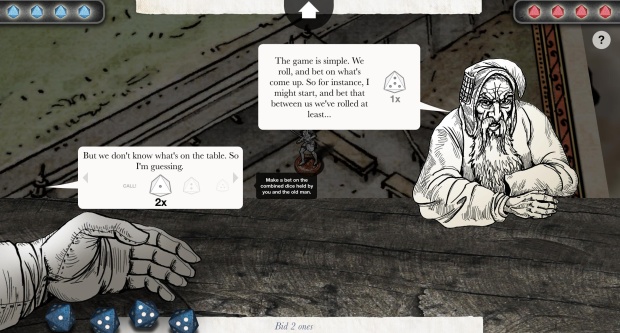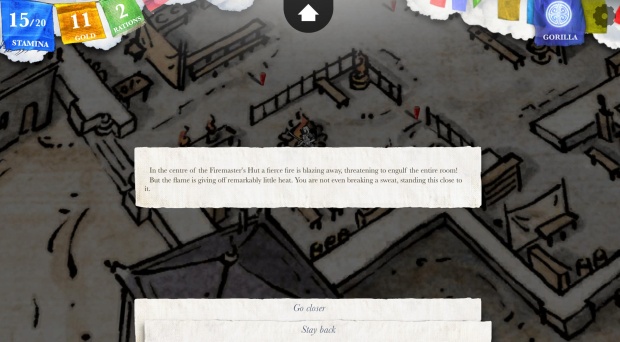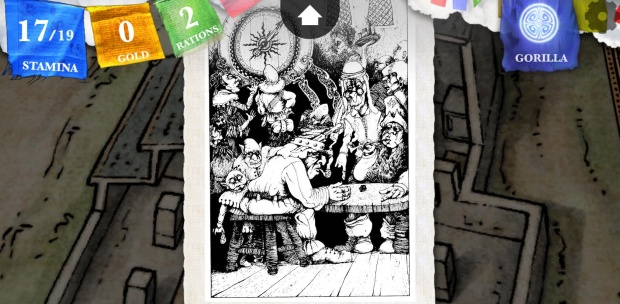Wot I Think: Sorcery! Parts 1 And 2
Turn to page 273
Three games into Inkle's four-part video game conversion of Steve Jackson’s legendary choose-your-own-adventure (CYOA) Sorcery! books, I decided I should catch up on the first two, and review them. Before noticing Richard already did. Oops. So, anyway, I’m covering the first two today, having chosen my own adventure through both. Then I’ll come on to the latest entry released last week. Of Sorcery! Parts 1 and 2 [official site], here's wot I think:
I’m very fortunate that I did enjoy a good few Steve Jackson and Ian Livingstone books as a kid in the early ‘80s, thanks to my father who was a big enthusiast, but I confess that I never did read the Sorcery! series. Although if they’re half as good as this video game conversion, I sure wish I had. The Sorcery games are such a splendid way to encounter a story, with genuinely wildly diverse paths and huge value in replaying, as well as far more RPG involvement than you’d likely be expecting.
Beginning as either male or female, a Warrior or a Sorcerer (or most likely, both), you are sent on a mission to recover the lost Crown of Kings, in order to save the lands from being taken over by an evil Archmage. This involves choosing routes, avoiding or embracing dangerous situations, making dialogue decisions, buying new equipment, managing rations, working for gold, and a clever fighting system of balancing strengths of attacks against concern for defence.
Replacing paper pages is an absolutely beautiful map, bulbous and textured, and a real pleasure to zoom around (with severe qualifications, as mentioned below). You drag the icon of your character from one spot to any of the potential destinations available, and off she or he trots. The rest is presented as text on the screen, but in a lovely scrolling screed that sews itself together as you make choices. Occasional illustrations from the original books appear, and although I find them dreadful, they provide some punctuation within the words.
The map helps add a good deal of a feeling of place to things, especially as it leaves a trail showing where you’ve been. It underlines how much variation there potentially is, letting you see which regions you entirely missed, or which routes around or through a town you chose.
Combat dispenses with the familiar dice rolls of the novels, and works by sliding your character toward the enemy a chosen distance. The farther you slide, the more powerful your attack. Stay still and you’ll defend. What you choose to do is based on what you guess the enemy will do, sometimes hinted at in the text descriptions of the fight. Defend and you’ll only lose one point of stamina against an attack of any strength, but if that attack was only – say – 1.3, you could have walloped it with a simply 2.0. Lunge at them with all your attack power and you’ll waste a massive pile of it if they defend, but could lop a chunk out of them if they perform a weaker attack. It’s so very simple, and yet interestingly involved, and the more stamina with which you come away from a fight, the better chance you have as the game goes on.
Spellcasting is nearly very faithful to the books’ intentions. Each spell is made of three letters, these dependent upon the position of the stars at the time (ie. the ones it lets you access at that moment), which if correctly combined (and you have necessary items for casting) will unleash magic. I was confused at first as to why I was being given the letters without simple access to the spellbook, until I read that in the original release of the books the spells weren’t even included, but sold separately! Later editions had them as an appendix, but you were still encouraged not to look them up as you played. It does stop short of committing to the idea, however, letting you try any combination of the available letters without casting on the final selection, and seeing what it will create, which is a bit of a disappointment I think.
I played the first game on my electronic telephone - the Sorcery series only finally ported to PC this year - and did so three times through. The first time I made poor choices, and by the end of the game I really wasn’t in any position to win a very difficult fight. But hurrah, the games simulate that old faithful of CYOA books: fingers and thumbs left as bookmarks of your moves! You can rewind your choices at any time, to any position in your current game, right back to the start. If you do so, of course, you’ll lose everything smart you did afterward too, and it’s remarkably difficult to remember exactly how you played each situation, and amazingly easy to find yourself on a completely different path.
I ended up starting it over and playing much more sensibly, and whomped that final fight with the help of a giant I magicked and the hefty broadsword I’d purchased – two things I didn’t even know could be done on my first go. Then I played a third time, this time as a complete prick, seeing if being horribly rude to people made a significant difference. Gosh, it does, right down to how the story is told.
Obviously my preferred route was the middle one, and I was disappointed at the idea of having to play a whole new route to carry on the series on PC. But no matter! A finished game offers a cloud save with a code, and starting Sorcery! 2 on PC, I popped in that code and the character and all her decisions and items transferred over. Completely splendid.
By Sorcery! 2 things get a little more complicated. Clues are added alongside your various inventories, allowing you to piece together the information you need to escape the dangerous city of Kharé, and there’s a greater sense of freedom, of being able to occasionally retrace your steps, slightly more puzzle solving.
It’s also a far, far bigger game, a straight run through the city lasting a lot longer than the first game, and that’s not including the need to repeatedly head back to earlier locations you missed the previous times if you’ve not gathered enough clues along the way. It feels enormous in comparison, far more involved, and with a huge amount of variation. It was a very smart decision to bundle parts 1 and 2 on PC, rather than sell them separately, as the result is one very lengthy adventure.
However, there are some serious problems with the PC port. At the more minor end is the frustratingly glitchy spell casting, where for no discernible reason clicking on a letter will cause it to start spinning, or select a letter from a different group, which is fiddly and annoying. Much more seriously, there are features that just don’t work properly. Sorcery! 2 introduces a dice rolling gambling game that works very well, except that the game mangles its presentation of the results meaning you can’t read the text. Even more rubbish, the map that is exquisitely wonderful on phones is all over the place on PC, with the zoom levels of a (wrong direction) mouse wheel roll ridiculously far apart (pinch zoom on Android appears completely smooth).
Unfortunately, this means that when in buildings, drawing a path from your character to the next destination can become annoyingly tricky, either too closely zoomed in to be able to see both at once, or zoomed out too far for them to be marked on the map. (Again, the phone build seems to have no problems showing your character from any distance.) It demonstrates a concerning lack of playtesting at different resolutions, and is such a long way from the adaptive loveliness of the telephone build that even lets you flip seamlessly from landscape to portrait.
Technical frustrations aside, this is a fantastic piece of work. As I mentioned at the start, I’ve not read Jackson’s originals, nor do I have them in front of me to meticulously check whether much new material has been added or taken away, but I am pretty certain that even the most diehard fans of the novels would be delighted by this conversion. It feels so much more involving than interactive fiction often can when just presented as text, but doesn’t get distracted by graphical features to dilute the effect of the narrative. This is really smart stuff, both in original content, and its execution.
Sorcery! Parts 1 and 2 is available now for Windows and Mac.







